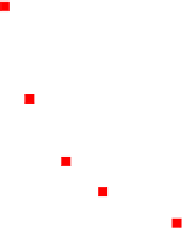Image Processing Reference
In-Depth Information
0.3
Measured peak
1/
N
s
2/(3
N
s
)
0.25
0.2
0.15
0.1
0.05
0
0
5
10
15
20
25
30
35
40
Number of sources
Figure 10.1
Filter peak values versus the number of sources used required causing the “combined cepstrum”
method to produce a reconstructed image.
of approximately 2/3. The peak values for each of the sources are shown in
Figure 10.1. In this figure, the trend line for this process is drawn and com-
pared with the ideal trend line of 1/
N
s
, which demonstrates the conclusion
of 1/
N
s
for the minimum constraint for the Gaussian filter for the “combined
cepstrum” method. In addition, the line for the “2/3” adjusted line for magni-
tude adjustment is also shown.
Using the “optimized” value for σ and the new peak scaling factor of 2/(3
N
s
),
the process was run again for the two triangles target set for various number of
sources using each of the processing methods for comparison of performance.
The results of this experiment are shown in Table 10.6. The “optimized com-
bined cepstrum” method appears to consistently perform the best out of all
the methods considered.
The final aspect of investigating filtering or removal of unwanted parts
of the spectrum or data consists of trying to remove or subtract a cepstrum
representation of the incident field, Ψ
inc
. The reasoning behind this, as dis-
cussed in Section 8.1, is that in the cepstrum domain, after the reference
has been added, we have a representation of
V
Ψ in the form of the following
approximation:
Ψ
�
V
RR
-
‚
+
≈
log
(10.2)
′
As discussed in Chapter 8, it appears that by subtracting a weighted ceps-
trum representation of Ψ
inc
we would then have
V
RR
Ψ
�
-
‚
+
≈
log
′
−
κ
(10.3)
inc
































Search WWH ::

Custom Search